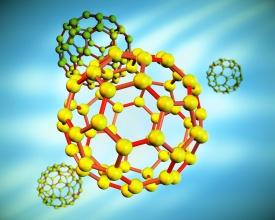

09/26/2011

With growing demand for renewable energy sources, devising new methods to improve the efficiency of photovoltaic materials is a key challenge in the production of next-generation solar cells based on organic materials rather than silicon. A team led by Tienan Jin from the WPI-AIMR in collaboration with researchers from China have now developed a novel strategy to produce organic solar cells using functionalized carbon ‘fullerenes’ with high yield and at low cost1.
Photovoltaic cells generate electricity from light based on a system of charge transfer between electron donor and acceptor molecules. Fullerenes — soccer ball-like spheres of carbon atoms — are widely used as an acceptor molecule in organic solar cells in the form of phenyl-C61-butyric acid methyl ester (PCBM), but this complex molecule is expensive to make and attempts to reduce production costs have so far met with limited success. Jin and his co-workers turned to the naturally occurring fullerene C60 as a lower-cost alternative to the C61 derivative. Functionalizing C60 to achieve the same level of electron acceptor performance, however, required the development of a new synthesis strategy.
The researchers functionalized the C60 fullerene (pictured) by grafting on alkyl chains. This type of modification has been performed in the past using magnesium- or lithium-based reagents, but these reactions often result in over-alkylation. Milder, more selective conditions are needed to produce the mono-functionalized fullerenes that are most suitable for use in organic solar cells. “We have previously developed a number of transition metal-catalyzed molecular transformations at carbon–carbon multiple bonds, so we investigated whether we could functionalize C60 in the same way,” explains Jin.
After an exhaustive search of possible catalysts and reaction conditions, the researchers found that a cobalt-based compound was the most efficient catalyst for this grafting reaction. Adding the C60 and an alkyl halide compound to a solution of the cobalt catalyst and a manganese reducing agent gave the mono-alkylated C60 fullerenes in 88% yield in 2 days. Using this efficient procedure, Jin and his colleagues were able to produce fullerenes bearing a zinc porphyrin, a branch-like dendrimer, and even another fullerene to afford a fullerene dimer or ‘dumbbell’ — all of which are difficult to synthesize by previous methods.
A simple organic solar cell with a bulk heterojunction structure constructed using the new fullerene derivatives achieved higher solar-to-electricity conversion efficiency than a comparable device prepared using the conventional PCBM electron acceptor. “Based on this promising result, we plan to design and synthesize other new fullerene derivatives with possible photovoltaic applications,” says Jin.
Lu, S., Jin, T., Bao, M. & Yamamoto, Y. Cobalt-catalyzed hydroalkylation of [60]fullerene with active alkyl bromides: selective synthesis of monoalkylated fullerenes. Journal of the American Chemical Society 133, 12842–12848 (2011). | article
This research highlight has been approved by the authors of the original article and all information and data contained within has been provided by said authors.